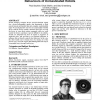Free Online Productivity Tools
i2Speak
i2Symbol
i2OCR
iTex2Img
iWeb2Print
iWeb2Shot
i2Type
iPdf2Split
iPdf2Merge
i2Bopomofo
i2Arabic
i2Style
i2Image
i2PDF
iLatex2Rtf
Sci2ools
HRI
2009
ACM
2009
ACM
Using bio-electrical signals to influence the social behaviours of domesticated robots
Several emerging computer devices read bio-electrical signals (e.g., electro-corticographic signals, skin biopotential or facial muscle tension) and translate them into computer- understandable input. We investigated how one low-cost commercially-available device could be used to control a domestic robot. First, we used the device to issue direct motion commands; while we could control the device somewhat, it proved difficult to do reliably. Second, we interpreted one class of signals as suggestive of emotional stress, and used that as an emotional parameter to influence (but not directly control) robot behaviour. In this case, the robot would react to human stress by staying out of the person’s way. Our work suggests that affecting behaviour may be a reasonable way to leverage such devices. Categories and Subject Descriptors I.2.9 Robotics. Operator interfaces General Terms Experimentation, Human Factors Keywords Robots, bio-electric signals, emotional control, OCZ NIA™, iRobot®...
Emotional | Facial Muscle Tension | HRI 2009 | Human Robot Interaction | Low-cost Commercially-available Device |
| Added | 19 May 2010 |
| Updated | 19 May 2010 |
| Type | Conference |
| Year | 2009 |
| Where | HRI |
| Authors | Paul Saulnier, Ehud Sharlin, Saul Greenberg |
Comments (0)

